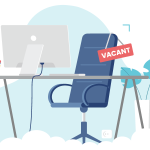How much will a bad hire really cost your business?
June 6, 2022

Talent attraction is a major priority for employers these days. While the Great Resignation didn’t hit Canada to the same extent as has the U.S., various workplace conditions, like hiring freezes, an aging workforce, and shifting employee attitudes about the nature of work, in general have contributed to widespread talent shortages.

As a result, employers across industries have become laser-focused on filling vacancies to meet current demands, regardless of candidates’ education, experience, skill, or cultural fit. According to a 2021 report from Robert Half, 77% of senior managers admitted to recruiting the wrong person for a role the year prior.
But good enough isn’t always good enough. The fact is: hasty hiring is one of the costliest mistakes a business can make. In addition to the upfront costs of recruiting and onboarding new employees, even one bad hire can have a ripple effect that impacts every aspect of your company’s performance, increases your liability exposure, and leads to an upswing in lawsuits.
Skeptical? Keep reading to learn why bad hires are a business risk no company can afford to take.
RELATED: Why are employers losing the talent war?
Disclaimer: Please note the information provided herein offers guidelines only and is presented from a liability-based perspective to help you avoid insurance claims. It is not exhaustive and should not take the place of legal advice. For specialized guidance, please consult a lawyer or a licensed insurance representative.
1. Turnover Costs
Most organizations tend to underestimate just how much time and money it takes to find, pursue, interview, and train new candidates. Plus, SMBs without a dedicated HR team or companies that are experiencing their own internal talent shortages might not have the time, budget, or personnel to devote weeks on-end to find the perfect candidate for each role if they have a mountain of positions to fill.
Even if you outsource the hiring part to a staffing firm or recruitment agency, the onboarding process can be long and complicated. You might need to set up third-party training or ask other employees to step in, or spend time bringing new hires up to speed yourself—costs that won’t be recovered if someone turns out to be wrong for a role.
2. More Mistakes and Accidents
Employees that aren’t the right fit for their role or for your company culture are likely to underperform, especially if they’ve been rushed through the onboarding process without sufficient time to review corporate policies. Perhaps a new hire isn’t fully aware of your business model. Or they don’t fully understand the role they play in your organization. Or maybe they don’t have the skills they claimed in their interview. Either way, they’re not producing the quality of work you agreed upon.
Then what? Incomplete projects. Dropped leads. Careless behaviour that leads to missed deliverables, unhappy clients, and lost profits. Poor service and shoddy work can strain the patience of even your most loyal clients, diluting brand trust and diminishing the goodwill you’ve worked so hard to build.
Employees that aren’t properly trained or paying attention to their duties might even be less aware of their surroundings, leading to an increase in safety incidents, jobsite injuries, and equipment breakdowns. That means more mistakes and accidents, which could also translate to more lawsuits against your business for negligence or third-party injury and property damage.
RELATED: The 8 Most Frequently Asked Questions About Professional Liability Insurance
3. Privacy Breaches
Your defense measures are only as good as the people who use them and new hires are particularly vulnerable to security mishaps, especially if organizations aren’t providing regular security awareness training. Someone new to your field may be unaware of sector-specific requirements on how to handle, store, or dispose of sensitive data. Or maybe they don’t know the key industry players well enough to be able to spot a phishing scam or signs of suspicious activity.
Distance is also a factor. With everyone working far away from the direct oversight of IT teams, even the most seasoned industry veterans might be less vigilant about installing software updates, maintaining password hygiene, sending data over unsecured connections, and more. Whatever the reason, security shortcuts by uninformed or irresponsible employees can leave the door wide open to malicious threat actors. Even worse? Overworked colleagues and managers might be too busy or stressed to report or even notice security concerns.
But keep in mind: regulatory bodies and clients won’t be too forgiving in the event of a breach, even if it was unintentional. It doesn’t matter how understaffed you are or whose fault it was, your organization is still responsible for all gaps in protection or breakdowns in security controls. And if you’re found negligent under PIPEDA or any other applicable provincial legislation, you could be liable for up to $100,000 in fines.
RELATED: All About Cyber Insurance: What is it, What’s Covered, and Why Do You Need it?
4. Reduced Morale
Workplace culture is more fragile than ever. And tossing in a lazy, incompetent, or rude employee is the quickest way to take down a once high-performing team. Whether it’s a manager or a team member, someone that’s constantly missing deadlines, causing accidents, or upsetting clients could put pressure on other team members to pick up the slack.
From there the issue could spiral. Employees that are already tired, unmotivated, or stressed out could quickly become burned out from extra responsibilities and time pressures. Overloaded and disengaged employees might even cause more mistakes, accidents, or security breaches while trying to maintain efficiencies. Senior executives are then stretched thin either playing the role of therapist to staff or trying to minimize the damage from slip-ups instead of focusing on innovation or corporate objectives.
If business leaders fail to take action against the bad hire, employees could become hostile, leading to harmful allegations of mismanagement, negligent hiring, unfair treatment, discrimination, harassment, and more against your company. Alternatively, they could quit, spiking your turnover rates and worsening the problem you had in the first place—talent shortages. And if they choose to spread word of the bad experience they had with your company, it’ll be even harder for you to attract new talent to replace them.
RELATED: Employment Practices Liability Insurance: What is it, What’s Covered, and What’s Not?
5. Increased Competition
It’s not just team members who’ll leave a toxic workplace; senior managers, leaders, directors, and officers might also quit if they feel their talents will be better appreciated elsewhere. And if they do, they could take valuable intel with them, like client lists, trade secrets, business strategies, and more, affecting your team’s ability to execute. Not only will you be combating the loss of key persons and organizational knowledge, you’ll be going up against former managers and supervisors that already know the ins and outs of your business operations.
Keep in mind: it’ll take time to train new employees to rebuild insider knowledge of your practices and processes and reach the same levels of productivity, so you could be affected for quite some time. Additionally, highly publicized departures of company leaders could also have a negative impact on your company’s valuation in the marketplace and reputation in the public eye.
RELATED: D&O Insurance: Sail Through Troubled Waters With Confidence
6. Business Crime
Background checks and screenings are crucial to protect against bad hires. But if you need someone to start immediately, HR might not have time to call all of a candidate’s references or perform your usual due diligence. That means you could miss out on some major red flags in an employee’s past that aren’t always obvious on their resume or application, like a poor work ethic, a bad attitude, or sticky fingers. It also means you could see a spike in cases of employee misconduct, like theft, fraud, forgery, and more.
Newbies might even be more inclined to commit fraud if they know you’re too busy to thoroughly investigate financial, safety, and auditing controls or they think you don’t have the resources to investigate fraud or pursue litigation. Remote work is another key driver; employees that have been onboarded virtually may not have had the opportunity to build company loyalty that would otherwise prevent malicious behaviour. And lack of direct supervision at home could make it even easier to steal or cause harm.
The Bottom Line: A bad hire will cost you more than time and money.
Ultimately most organizations will agree that the true cost of a bad hire is not a price they are willing to pay. People are your most critical business asset and once someone you hired consistently fails to deliver on work, attitude, or aptitude, they’ve become a liability.
While you might have insurance to offset the financial loss from a lawsuit, it’ll be much harder to recover from the long-term effects of lost morale, productivity, organizational knowledge, and brand trust—devastating costs for any organization, but particularly for businesses that are already struggling with budget constraints in a post-pandemic market. And if you don’t address the root of the problem, these costs will only continue to rise.
RELATED: Talent Attraction Strategies in a Job Seeker’s Market
So what can you do?
In order to avoid the risks, costs and staffing headaches that accompany a bad hire, it is imperative for all employers to recognize human capital as a core tenet of risk management and work to reduce their exposures.
Look for the right talent for your needs, not just the best talent or available talent. Come up with a dedicated hiring strategy that meets both current and emerging needs. Apply the same rigor and resources that you would spend on any other critical business function to talent acquisition and work continuously to optimize your costs and processes. And to attract new talent and retain existing staff, implement robust benefits and wellness plans that support employees’ in all aspects of their lives and protect their physical, mental, and financial health.
For more guidance on how you can combat the liability risks of a bad hire, connect with PROLINK. As a licensed broker with over 40 years of experience, we understand the unique challenges you face, regardless of your company’s size, trade, or workforce. Our dedicated advisors will help you:
- Identify and assess your risks so you can make informed decisions about talent attraction;
- Align your organization with specialized risk management, insurance, and group benefits solutions that will reduce your exposures and help you boost hiring outcomes;
- Continuously monitor your plan so that it evolves to meet your needs long-term while keeping costs predictable.
Connect with PROLINK today to learn more!
PROLINK’s blog posts are general in nature. They do not take into account your personal objectives or financial situation and are not a substitute for professional advice. The specific terms of your policy will always apply. We bear no responsibility for the accuracy, legality, or timeliness of any external content.




